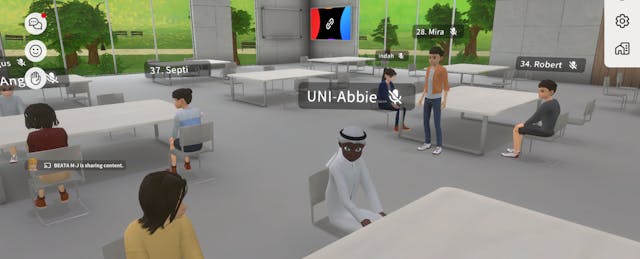The metaverse, a virtual, interconnected, and immersive digital space where users can interact with each other and digital environments, holds tremendous potential to transform education. It can facilitate immersive learning environments, allowing educators to craft virtual classrooms or historical settings so that students engage in interactive and captivating lessons. Collaborative learning thrives in the metaverse, fostering teamwork and cross-cultural communication as students from different locations collaborate on projects. Experiential learning is enhanced, offering a safe platform for hands-on activities like science experiments. AI-driven avatars and virtual tutors enable personalized learning experiences, catering to individual learning styles. Geographical barriers are dissolved, granting global access to high-quality education for students from diverse backgrounds.
Beata Mirecka-Jakubowska, the founder and CEO of Intercultural Education Consulting Group, has 36 years of international classroom experience. She turned to ViewSonic’s 3D immersive platform UNIVERSE with her online graduate students in Indonesia and later tried it with the Connected Learning project team in Iceland. Mirecka-Jakubowska has a contagious passion for learning and urges educators to embrace this new technology. EdSurge had the opportunity to speak with Mirecka-Jakubowska about her exploration of UNIVERSE, its impact on student engagement, the need for open-mindedness among educators and the exciting potential of the metaverse in education.
EdSurge: How did your teaching journey lead you to try UNIVERSE with your college students?
Mirecka-Jakubowska: That’s a very long story that goes back to the 1970s when I attended the United Nations International School in New York. [Laughs]. I learned early to be open to change. I had very good training as a substitute teacher in my first year at TASIS Hellenic International School in Greece. I went to school every morning, and whoever was absent, I replaced that person. So I taught Greek, Arabic, PE, first grade, 12th grade, IB, middle school — anything! How did I teach Arabic when I had no clue what the individual letters even looked like? I tried to be creative, use the resources around me and empower my students. I gave the reins to my students, and they loved it! That got me thinking about student-centered learning — something not well known back then. With that knowledge, when I moved to Jakarta International School in Indonesia, and with the help of several dear colleagues, we began creating student-centered programs.
When technology evolved in the late 1990s, first with email and then websites, the school’s IT head said, “Trust me, you want to learn all of this.” So, that’s what I did. I trusted him, and I even learned to code. As technology continued to develop, I often thought, Oh, that’s something my students need to know for their future. Who’s going to teach them? And I realized I’m the one who is going to teach them these skills. I integrated project-based learning and technology in all kinds of ways. I asked my English language learners to create films. I asked them to create websites. I asked them to create blogs to interact through blended learning. Did we have failures? Absolutely. There was always something to improve, something that went wrong. But I would tell my students, We will learn from this. What can we do better next time?
In 2018, I attended a workshop where I talked with a game-app developer. We started talking about gamification and how we could use games in a different way, a more developmental way. I envisioned a classroom with avatars who work on interactive projects together, and students could log in from anywhere. Then, in 2022, I was at the Singapore EDUtech Asia conference, and as I was walking by the booths, I saw my vision had become a reality. I thought, How is it possible that somebody else made my dream come true? I tried UNIVERSE there, and it blew me away. I could walk between student groups and hear all the conversations. I could stop and talk but still hear other groups in the background. It was totally different from [video conferencing]. And I knew I had to use it with students.
How did UNIVERSE help increase student engagement and interactions for learning in a virtual setting?
I noticed during the class that everyone wanted to say something. Even those students who were not usually talkers were super engaged. Those who were normally reluctant to speak seemed to speak up, perhaps because of their fascination with the technology or because they could be avatars. Their shyness was detached; they could try on a different persona and change their interactions in the classroom. They seemed to feel safe speaking among the cacophony of other voices in the background.
One exercise that worked very well was the interactive Collaboration Board. I placed an image with a question on the board, and all the students responded either with sticky notes or text. That is a great writing and thinking tool. And then there is that fantastic button that the teacher can press, and all of the avatars are seated and muted. I think UNIVERSE has great potential.

What challenges did you work through during the implementation process?
The preparation involves designing the classroom. Teachers need to think about how to set up the flow of the room for the best experience. It takes time to navigate everything and learn the technology. It takes time to teach the technology to students. A teacher probably won’t get everything done on the first try. The adaptability, flexibility and creativity of the teacher will play a huge role in designing and implementing a lesson in the metaverse to have learning outcomes that surpass those of the traditional classroom.
For students who logged in from different islands around Indonesia, sometimes their Wi-Fi wasn’t strong enough to carry their voices without breakage. But the drawbacks of the experience were mainly technical. Once we worked through what we could, students completed several tasks and activities in UNIVERSE for about 50 minutes and didn’t want to leave.
What guidance can you offer educators who are considering incorporating metaverse experiences into their teaching environments?
My advice is to be open-minded. Embrace the changes and embrace the challenges. Some teachers worry about students using Chat GPT, so they say it is forbidden in their classes. That is similar to 10 or 15 years ago when teachers said phones are forbidden in class; put them on the side. And I said, no, bring the phones in. That's your dictionary. That's your resource. Learn to use it wisely and manage distractions. Learning how to use the metaverse wisely is something to bring to the table with that open-mindedness because we are never going to stop technology. Technology is on a course of its own. We must embrace new technology and improve upon it to enhance learning. This is history in the making, and it is exciting to be a part of it!



